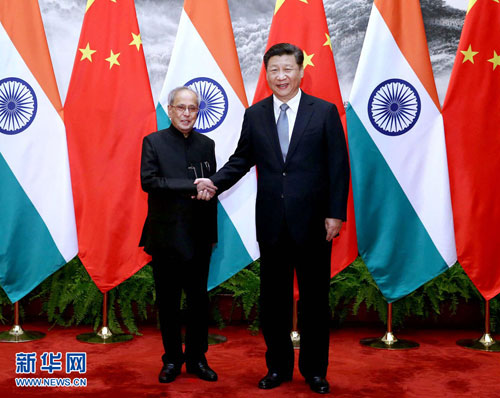Mukherjee to China: Mission to soften bilateral hard lines
- By Shastri Ramachandaran
 0 Comment(s)
0 Comment(s) Print
Print E-mail China.org.cn, June 1, 2016
E-mail China.org.cn, June 1, 2016
|
|
|
Chinese President Xi Jinping (R) shakes hands with Indian President Pranab Mukherjee in Beijing, capital of China, May 26, 2016. [Xinhua/Liu Weibing] |
Indian President Pranab Mukherjee's four-day visit to China on May 24-27, 2016 was of much more than symbolic importance. Contrary to the customary perception of a presidential visit as one loaded with ceremony and lacking in content, Mukherjee's mission was strategic. And, as a strategic interlocutor, he covered significant ground with finesse and savvy, as only he could have done.
President Mukherjee's main achievement was to bring a balmy touch to Sino-Indian relations which have been going through a rough patch in recent months. His talks were calculated to reassure his hosts that India values its relations with China, that India was not a part of any containment games aimed at China, that the country was prepared to do business and welcome investments from China, and that "enhanced cooperation" can resolve both the trade and trust deficits.
This has to be viewed in context. In the Indian scheme, although the President is the head of state and Supreme Commander of the armed forces, his position is very different from that of President Xi Jinping and U.S. President Barack Obama. He was not directly elected. Instead, he was elected by an electoral college comprising members of the Indian Parliament and state legislative assemblies. He is a titular head with a largely ceremonial role. The powers and functions of the President are exercised by the Prime Minister and his Council of Ministers. Generally, the President acts on the aid and advice of the Prime Minister and his Council.
However, Pranab Mukherjee is one of the world's most accomplished political leaders with vast and varied experience in international negotiation, diplomacy, economic affairs and finance. His 50 years in politics, government and foreign affairs, and strong grasp of Sino-Indian relations imbue his role with a certain power and force that is also recognized in China. He is no stranger to China, having visited the country as India's Defence Minister (2006), External Affairs Minister (2008) and Finance Minister (2011) before he became President in July 2012.
Therefore, given the series of prickly issues which had cumulatively cast a shadow on Sino-Indian relations, Mukherjee's visit was very important. It was an occasion for India to convey its messages that would put the Chinese leadership at ease without being defensive in the pursuit of its own interests.
There have been many high-level exchanges since Prime Minister Narendra Modi's visit to China in May 2015. Home Minister Rajnath Singh visited China towards the end of 2015. From China, Zhang Dejiang, chairman of the Standing Committee of the National People's Congress, Chinese Vice President Li Yuanchao, and Fan Changlong, vice chairman of China's Central Military Commission, traveled to India. In the early part of 2016, there were high-level visits to and from both sides. The foreign ministers of India and China met at the Russia-India-China Summit and also engaged in bilateral talks during the occasion. India's Defence Minister Manohar Parrikar visited China as did National Security Advisor Ajit Doval for the Special Representatives' talks on the boundary issue.
For all that, both Beijing and Delhi were at odds when it came to India's membership of the Nuclear Suppliers Group (NSG) and in getting UN sanction against Masood Azhar as a terrorist. Beijing was also angered when Delhi issued (and, later revoked) visas issued to Uygur and other Chinese dissidents for a conference in Dharamsala, which is home to the Dalai Lama and the Tibetan Government-in-Exile. One of the Uygurs given a visa was designated as a terrorist by Beijing and there was an Interpol notice out on him.
These developments further muddied bilateral relations already characterized by irritations and a lack of political trust. The erosion of trust was causing concern on both sides as more high-level interactions, including those of multilateral and strategic importance, are scheduled for later this year. In September, Prime Minister Modi is billed to attend the G20 Summit in Hangzhou. In October, President Xi Jinping will be going to the BRICS Summit in Goa.
Understandably, either side felt a need to clear the air and create conditions conducive to more pleasant and productive exchange. Doubtless, President Mukherjee's visit served to drive home the point that India greatly values its relations with China and reassure the country that at all times India shall strive for a cooperative and mutually beneficial relationship.
Thus, more than another high-level interaction, it turned out to be "the highest of high-level visits" in 2016 because of Mukherjee's political stature. Such high-level exchange is necessary in stabilizing Sino-Indian ties, particularly when there is a glaring lack of trust.
To that extent, the Mukherjee Mission had a tremendous impact. It may have a positive bearing on the issues that have upset the equilibrium of Sino-Indian relations. In the meantime, both the political atmosphere and tone appear to have changed for the better.
The writer is an independent Indian political and foreign affairs commentator. He is a Senior Consultant & Editor of China-India Dialogue, published by China International Publishing Group (CIPG).
Opinion articles reflect the views of their authors, not necessarily those of China.org.cn.







Go to Forum >>0 Comment(s)